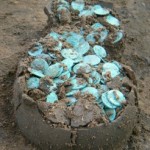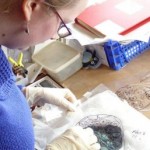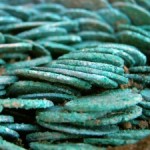
Latest news from Philip Crummy at the Colchester Archaeological Trust
In the days before banks, people would bury their money in pots for safe keeping rather than leave them lying about the house under the bed or in a cupboard. The money would be safe but things could still go wrong. Occasionally, the owners couldn’t find it again – imagine the panic! – or sometimes they died without telling anybody where they had hidden their cash.
Something like this must have happened on the site of the Hyderabad and Meeanee barracks on Mersea Road Colchester where last March we found a hidden stash of 1,247 Roman coins. They lay inside a small grey-ware pot which had been buried in the ground at a slight angle.
The coins are of a type known as antoniniani. The hoard is made up of issues of at least nine Roman emperors ranging from Gallus (251-3) to Victorinus (269-271). The latest coins in the hoard point to a date for its deposition in the early part of AD 271.
The antoninianus started life off as a silver coin issued in the early 3rd century but, by the time of the Hyderabad hoard, it had become very debased and ended up as a copper-alloy coin with a very thin silver coating. Severe inflation reduced its monetary value which is why later antoniniani are common finds on archaeological sites of the third quarter of the 3rd century. The Hyderabad hoard belongs to this period.
The burial of coins seems to have been more common in periods of unrest or uncertainty. The 270’s was a difficult time in eastern England because of civil war in the Roman Empire and serious raiding along the coast by foreign peoples. This explains why the Hyderabad hoard is not the first hoard of this period to have been discovered in the Colchester area. Over a hundred years ago, one, possibly two, hoards of the date were found in Colchester itself although the precise find spot is not known. Also over 6,000 antoniniani were found in three pottery vessels at Gosbecks in 1983, the latest coins dating to between AD 270 and 274. And some distance from Colchester, a hoard of about 657 antoniniani was discovered at East Mersea in about 1980. This fits the pattern with its latest coins being again in the range of 270 to 274.
When discovered, the Hyderabad hoard was carefully removed intact from the site and excavated indoors so that the positions of all the coins could be studied and recorded as the pot was emptied. The distribution of the coins in the pot in relation to their dates suggest that the coins had all been placed in there at the same time. In other words, no clear evidence was found to suggest that the pot had been used like a piggy bank with coins being added as time passed by. Instead all the coins appear to have been put in the pot at the same time and then buried. Interestingly many of the coins inside the pot looked as they had been placed in there in little stacks. From this, we can visualise the owner sorting out his money into neat piles on a table so that he could count it accurately before putting the coins in the pot stack by stack.

Samuel Pepys famously recorded in his diary what could go wrong if you had to resort to digging holes to protect your savings. The Dutch fleet was about to sail up the Thames and consequently Pepys, living in London, was worried about his money. So he decides to ask his wife to take £1300 in gold secretly to his father-in-law’s house in Brampton in Huntingdon and bury it there. But, horror of horrors, his father hadn’t a clue how to carry out this relatively easy task. The man simply buried the money in the middle of his front garden and, worse, did it in broad daylight for all to see. A few months later, an anxious Pepys was in the garden himself. He waited until it was dark, lit a candle, and then got to work. He found the buried treasure sure enough but – oh no! – the bag had rotted and, despite some frantic sieving, about 25 coins couldn’t be found.
The Hyderabad hoard had not been buried in somebody’s garden. Instead it looks as if it had been buried in the side of a field well away from prying eyes. The place were it had been hidden turns out to have been an interesting one because it was part of one of the defensive earthworks which protected pre-Roman Colchester (Camulodunum). This system of earthworks, known as dykes, originated up to a hundred years before the Roman invasion of Britain and the subsequent foundation of Roman Colchester. The Hyderabad hoard had been buried in the upper part of the filling of the ditch of the Berechurch Dyke which, until the recent excavations, had not been traced this far north. The dyke system at Colchester included at least 15 miles of earthworks and represents the largest complex of its type and date in Britain. This latest discovery adds about another half a mile to known extent of the complex.

The discovery of hoard has been reported to the Portable Antiquities Scheme and Treasure Department at the British Museum. The landowner, Taylor Wimpey, will then donate the hoard to the Colchester Museum and the people of Colchester just as they are doing with all the other finds from their sites on former Colchester Garrison land.
The excavations at the Hyderabad and Meeanee site were carried out by the Colchester Archaeological Trust on behalf of Taylor Wimpey who have funded all the work. RPS act as archaeological consultants to Taylor Wimpey and manage the project on the company’s behalf.